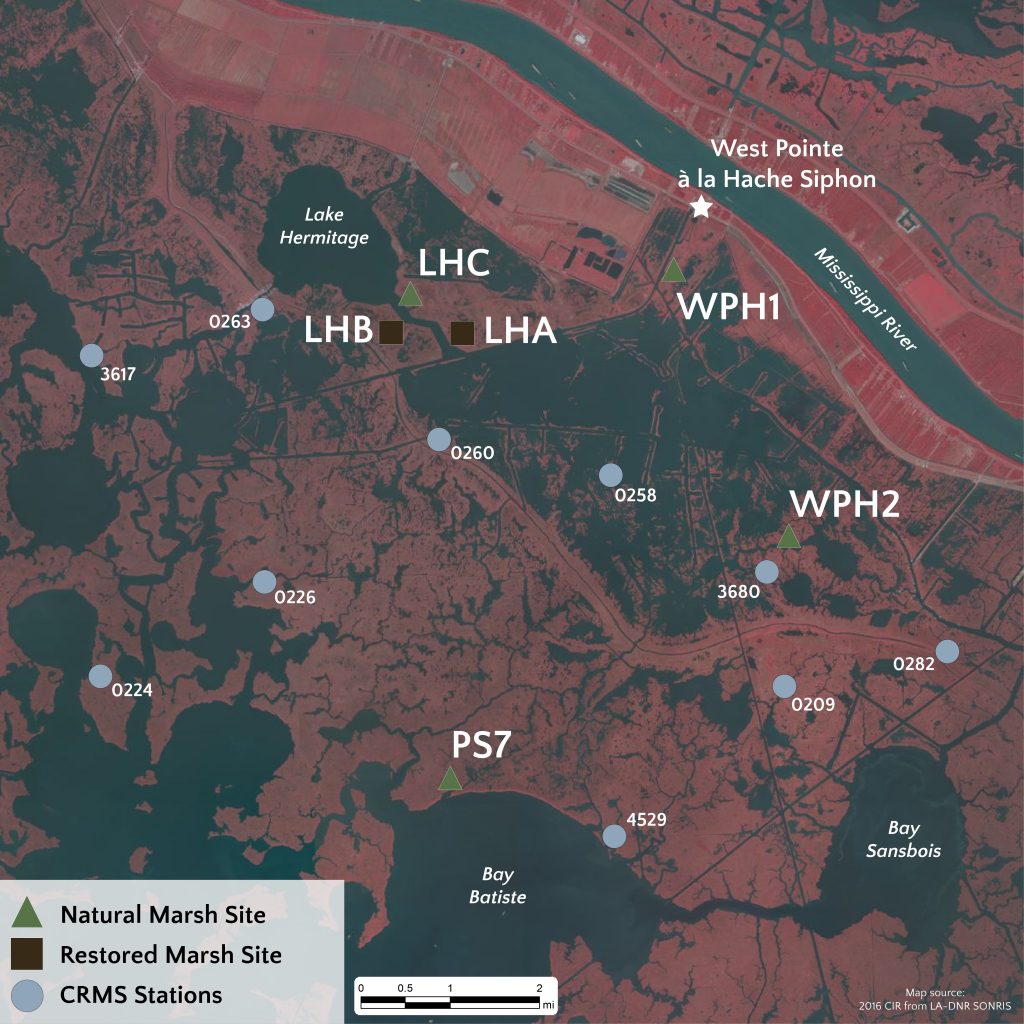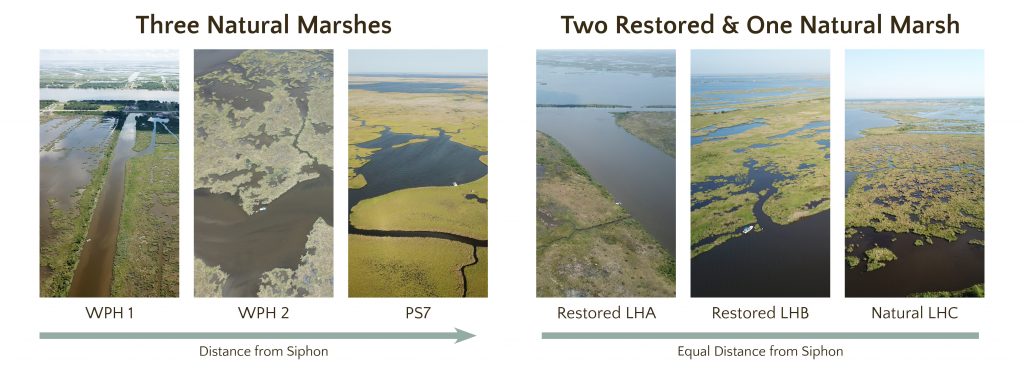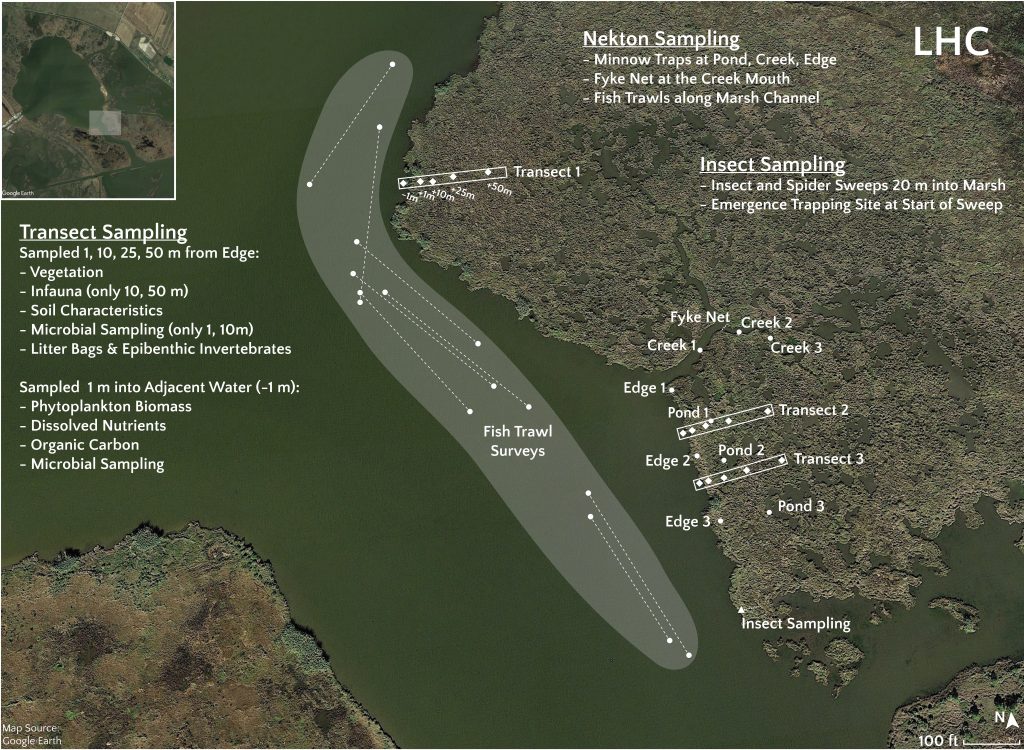We are focused on marshes, natural and created along a salinity gradient from a Mississippi River siphon at West Pointe à la Hache to the west of the Mississippi River into the upper end of the Barataria Bay system in southeast Louisiana.
Natural and created marshes along a salinity gradient and affected by a Mississippi River siphon serve as study areas.
Sampling Locations

Natural and created marshes along a salinity gradient and affected by a Mississippi River siphon provide the basis for comparative measures and food web studies. Marsh sites were selected based on condition (created or natural) and distance along a salinity gradient from the West Pointe à la Hache (WPH) Mississippi River siphon. The study area includes three natural marshes along the salinity gradient and a cluster of two created marshes and one natural marsh near the WPH siphon.
Continuous data loggers monitor salinity, water levels and other hydrographic parameters, within the broader area of Coastal Protection and Restoration Authority (CPRA) Coastwide Reference Monitoring System (CRMS) sites and are used as reference sites for this project.
Sampling Design

A series of biological, hydrographic and geologic parameters are studied in each marsh area during the high Mississippi River stage in spring, hopefully with a targeting of the opening of the siphon. The created marshes are part of the Lake Hermitage Marsh Creation Project. At the time of our sampling, the created marshes are 5 to 7 years of age. The siphon was off for sampling years 2018/2019 and on during sampling years 2020/2021.

Nekton and Invertebrate Food Web Sampling
Sampling at each marsh site includes a 50-m x 50-m region of the marsh platform, as well as associated subhabitats, including ponds, tidal creeks, marsh depressions, subtidal edge, and the main channel adjacent to the marsh.
Water column: Pelagic primary producer biomass (chlorophyll a), particulate organic carbon (POC) on screened (105-mm) and unscreened water samples for water adjacent to the marsh edge, and water quality measurements (e.g. temperature, salinity, turbidity, nutrients, etc.).
Microbial composition: from subhabitat water using rRNA gene profiles generated from single gene and metagenomics approaches and quantitative PCR (qPCR) methods.
Marsh fish and nekton: composition and abundance (catch per unit effort) with fyke nets and wire mesh traps. Fyke nets, 3-mm mesh netting, are placed along the marsh edge while the marsh is flooded and collect nekton when the flooded marsh drains.
Wire mesh traps (41 cm long, 22 cm wide, with 3-mm mesh), baited with dry dog food, are placed in all marsh subhabitats (edge, creek, ponds, depressions) are used to count the number and types of fish captured per minute (CPUE). Off-marsh fish and nekton are sampled with replicated tows of a 5-m otter trawl behind a vessel traveling ~2.5 knots (catch per minute).
Sampled nekton (species and size) are used for community structure, and isotopic and fatty acid indicators for food web development
Transect Sampling
The sampling design is a combination of transects through the marshes at pre-established distances from the water, and adjacent water, and as specific habitat types for the focus on food web components. Transects into the marsh are sampled at each study site – three in 2018, one in 2019 onward. The along-transect stations are 1 m, 10 m, 25 m, 50 m and 100 m into the marsh. There is an additional station in the adjacent channel for the collection of phytoplankton and water quality.
Marsh platform characteristics: All three transects, all distances. Plant composition and biomass, clipped plots (0.25-m x 0.25-m quadrats), C and N content of plants, sediment microalgae by chlorophyll a biomass, phytoplankton biomass in adjacent waters (chlorophyll a), sediment organic C and total N concentrations, and sediment grain size.
Macroinfauna (retained on a 0.5-mm sieve): On a single transect, middle position, five replicate cores at 10-m and 50-m distances into the marsh, along with a sediment grain size sample for each infauna core.
Microbial composition: Microbial diversity at 1-, 5- and 10-m on the marsh platform from the water’s edge, and 1-m off the marsh edge in intertidal water.
Epibenthic macroinvertebrates: At 1-m and 10-m distances (0.25-m2 quadrats), counts and measured sizes of fiddler crabs, marsh periwinkles, and Gulf ribbed mussels, crab density by burrow count and crab size by burrow opening diameter.
Insects and spiders: Sweep nets on pre-determined distances to 50-m inland for a total of 100 m2.